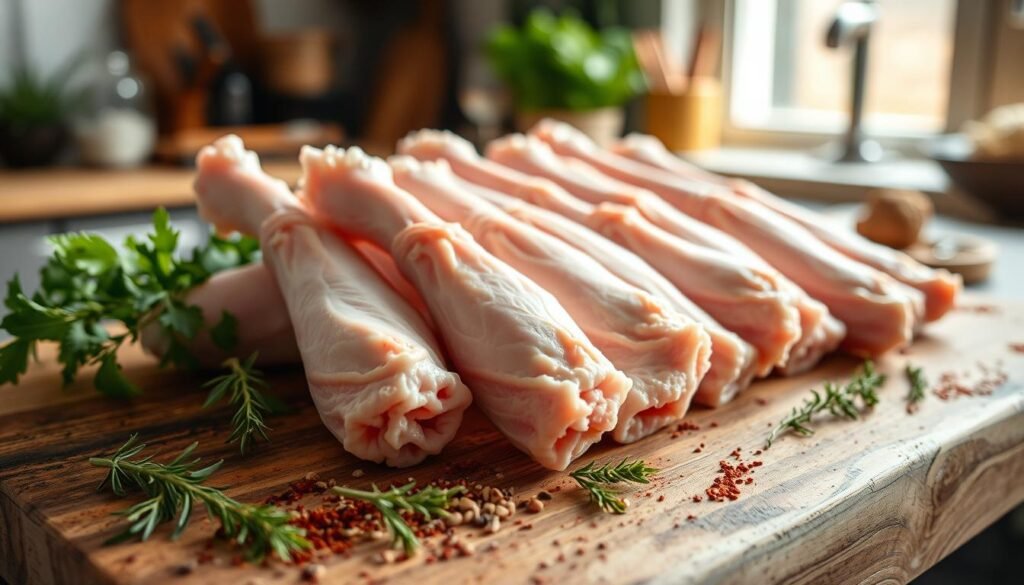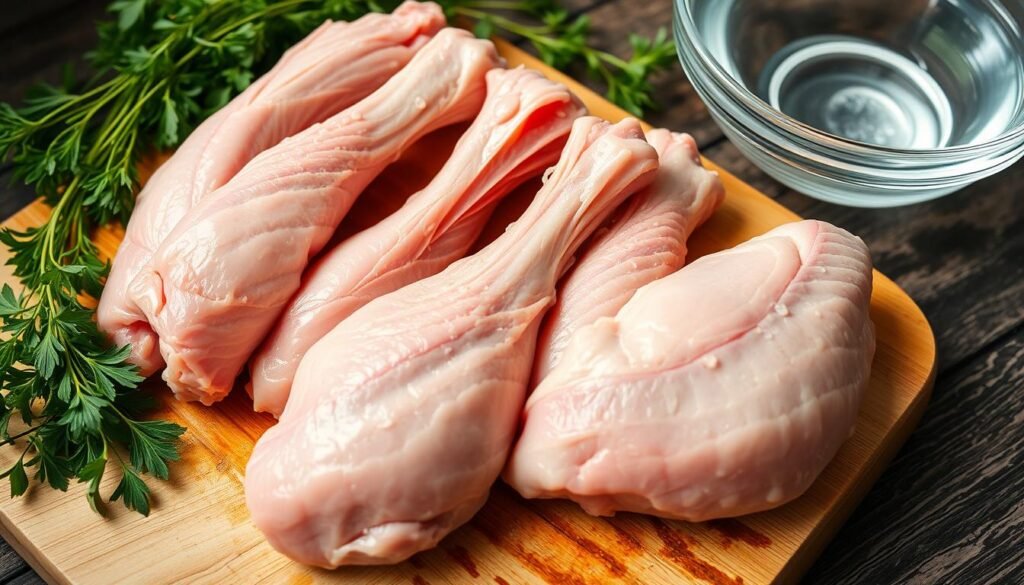Turkey necks are a favorite chew for dogs, found in raw or dried forms. Can dogs eat Turkey necks? They offer mental fun, dental benefits, and are packed with protein and nutrients. But, there are dangers like bacterial contamination and choking risks. This guide will help you understand the good and bad sides of turkey necks for dogs.

Key Takeaways
- Turkey necks can be a nutritious addition to a dog’s diet when fed properly.
- Potential benefits include dental health, mental stimulation, and protein-rich nutrition.
- Risks include choking hazards, bacterial contamination, and digestive issues.
- Proper selection, handling, and portion control are crucial for safe feeding.
- Consult your veterinarian before introducing turkey necks to your dog’s diet.
Understanding Turkey Necks: What Are They?
Turkey necks are the neck part of a turkey, without the head, skin, and crop. They are made of the spine, vertebrae, trachea, muscle, and connective tissue. They can be up to 10-12 inches long. Turkey neck bones for dogs are a favorite natural treat and come from the poultry industry.
Anatomy of Turkey Necks
The raw turkey necks for dogs have different parts that are good for dogs. The vertebrae and spine help clean teeth naturally. The soft tissues, like muscle and connective tissue, make for a fun chew.
Types of Turkey Necks Available
- Fresh or frozen raw turkey necks for dogs, from poultry farms or processing places
- Dehydrated turkey necks, air-dried to keep nutrients and texture
Raw vs. Dehydrated Options
Both raw turkey neck bones for dogs and dehydrated turkey necks have their benefits. Raw necks give a natural chewing experience. Dehydrated ones are easy to store and use. Always pick high-quality, free-range options for your dog’s health and happiness.
Can Dogs Eat Turkey Necks: Safety and Guidelines
Turkey necks can be a safe and healthy treat for dogs, but it’s important to follow some rules. Never cook raw turkey necks because it can cause bones to splinter and hurt your dog’s insides. Dehydrated turkey necks are safer because they’re made at low temperatures to avoid brittleness.
It’s key to watch your dog when they have a turkey neck. Make sure they don’t swallow it whole to avoid choking or blockages, especially in smaller dogs. Also, be careful of bacteria like Salmonella and E. coli that can be in raw turkey necks.
Not every dog can have turkey necks. Talk to your vet before giving them to your dog, especially if they have health issues or dental problems. Senior dogs or those with dental issues need extra care when eating turkey necks.
| Feeding Guideline | Recommendation |
|---|---|
| Portion Size | Offer half to one complete turkey neck two to three times a week as a chew, depending on your dog’s size. |
| Preparation | Rinse turkey necks, trim excess fat, and cut them into smaller pieces to prevent choking. Cooking is safer than raw. |
| Supervision | Always watch your dog while they have a turkey neck to prevent choking or digestive problems. |
By following these guidelines and talking to your vet, you can safely add turkey necks to your dog’s diet. This way, you can give them the benefits these natural treats offer.
Nutritional Benefits of Turkey Necks for Dogs
Turkey necks are great for our dogs. They are full of protein and essential vitamins and minerals. These benefits help keep your dog healthy and happy.
Protein and Fat Content
Turkey necks have about 55% meat and 45% bone. This makes them a top-notch protein source. Protein is key for muscles, organs, and growth in dogs. The fat content also gives energy and helps with vitamin absorption.
Essential Vitamins and Minerals
Turkey necks also have lots of essential vitamins and minerals. They have calcium, phosphorus, iron, and more. These help with strong bones, a healthy immune system, and nerve function.
Natural Joint Supplements
Turkey necks are special because they have glucosamine and chondroitin. These help with joint health and mobility. They’re great for dogs with joint problems or older dogs.
“Turkey necks offer a nutritional powerhouse that can benefit dogs in numerous ways, from supporting muscle development to promoting joint health.”
While turkey necks are not the only food for your dog, they’re good in a balanced diet. Always introduce new foods slowly and watch how your dog reacts.
Dental Health Benefits and Mental Stimulation
Chewing on turkey neck chews for dogs does more than just entertain your pet. These treats can also improve your dog’s dental health and provide mental stimulation. Both are key to your dog’s overall health and happiness.
Chewing on turkey necks can help clean your dog’s teeth. This can reduce plaque and tartar, which are common causes of dental problems. Up to 80% of dogs get periodontal disease by age two. So, while turkey neck chews are helpful, regular dental care and vet visits are still crucial.
Turkey neck chews for dogs also offer mental benefits. Dogs love to chew, and these treats keep them busy and happy. A turkey neck can last 20-30 minutes of chewing, providing entertainment and reducing boredom and stress.
“Raw bones were indicated as a valuable source of calcium and phosphorous when included in a nutritionally complete, home-prepared diet but should be ground thoroughly before feeding to minimize risks.”
But remember, turkey necks are not a full replacement for vet care and dental cleanings. Always watch your dog when they’re chewing to keep them safe.

| Dental Benefits | Mental Stimulation |
|---|---|
| Reduce plaque and tartar buildup | Satisfy natural chewing instinct |
| Contribute to better dental health | Alleviate boredom and reduce stress |
| Supplement regular dental care | Engage dogs for 20-30 minutes |
Potential Health Risks and Safety Concerns
Turkey necks can be good for dogs, but there are risks. It’s important for pet owners to think about these before giving them to their dogs. They should weigh the good against the bad.
Choking Hazards
Turkey necks can be a choking hazard, especially for dogs that eat fast. They are big and can block a dog’s airway. It’s key to watch your dog closely when they eat turkey necks.
Bacterial Contamination
Raw turkey necks can have bad bacteria like Salmonella. This can make dogs sick with vomiting and diarrhea. Cooking or using dehydrated turkey necks can help avoid this.
Digestive Issues
Turkey necks have a lot of fat and bones. This can cause stomach problems in dogs. Watch your dog for signs of trouble and talk to a vet if needed.
Before giving turkey necks to your dog, think about the turkey neck risks for dogs, dog health concerns, and bone hazards for dogs. Always put your dog’s safety first when choosing their food.
Proper Feeding Guidelines and Portions
Feeding turkey necks to your dog should be done with care. They should be seen as treats, not a meal substitute. Make sure the turkey neck fits your dog’s size to avoid choking hazards.
Medium-sized dogs can have one dehydrated turkey neck 1-2 times a week. You should also adjust their regular meals to balance the extra calories. Always watch your dog when they eat a turkey neck and remove any small pieces to avoid choking.
- Offer turkey necks as occasional treats, not meal replacements.
- Adjust your dog’s regular meal portions to accommodate the calories from the turkey neck.
- Supervise your dog while they’re eating the turkey neck and remove any small, leftover pieces.
Remember, the how to feed turkey necks to dogs and turkey neck portions for dogs depend on your dog’s size, age, and activity level. Talk to your vet to find the right dog feeding guidelines for your dog.

“Dental disease is the most common disease in dogs, affecting 76% of all canines in the United States, with a 23.3% increase in prevalence since 2006.”
Turkey necks can help your dog’s dental health by removing plaque and tartar. But, watch your dog closely and adjust how often and how much you give them to keep them safe and healthy.
Selecting Quality Turkey Necks for Your Dog
Feeding your dog turkey necks can be a great choice. But, it’s important to pick the right ones for their health. Let’s look at what to consider when choosing turkey necks for your dog.
Source and Quality Indicators
Choose turkey necks from trusted suppliers that follow strict food safety rules. Look for products meant for humans or pets. Free-range, antibiotic-free turkey necks are best to avoid harmful substances.
- Prioritize turkey necks from trusted, high-quality sources
- Seek out products labeled for human consumption or pet use
- Opt for free-range, antibiotic-free turkey necks when available
Storage and Handling
Storing and handling turkey necks right is key to keeping them safe and fresh. Freeze raw turkey necks until you’re ready to use them. Thaw them in the fridge, not at room temperature. Dehydrated turkey necks should be kept in a cool, dry spot. Always wash your hands and clean surfaces when handling raw turkey necks to avoid bacteria.
- Store raw turkey necks frozen until ready to use
- Thaw in the refrigerator, not at room temperature
- Store dehydrated turkey necks in a cool, dry place
- Practice proper hygiene when handling raw turkey necks
By following these tips, you can make sure your dog gets the best turkey necks. This way, they can enjoy this tasty and healthy treat safely.
“Proper storage and handling of turkey necks are crucial to maintaining their safety and freshness.”
Which Dogs Should Avoid Turkey Necks
Turkey necks can be a tasty treat for many dogs. But, not all dogs can safely enjoy them. It’s important for pet owners to be careful when giving turkey necks to their dogs. Some health issues or life stages might make them unsafe or risky.
Dogs with pancreatitis, diabetes, or obesity should avoid turkey necks. They have too much fat, which can worsen these conditions. Dogs with sensitive stomachs or past digestive problems might also have trouble digesting turkey necks, leading to stomach upset.
Puppies and older dogs need extra care with turkey necks. Puppies have growing teeth and a weak immune system, making them more likely to choke or get intestinal blockages. Older dogs might have dental or immune issues that make eating turkey necks dangerous.
- Dogs with pancreatitis, diabetes, or obesity should avoid turkey necks due to their high fat content.
- Dogs with sensitive stomachs or a history of gastrointestinal issues may struggle to digest turkey necks.
- Puppies and senior dogs should generally avoid turkey necks due to dental and health concerns.
- Dogs on special diets or with specific health conditions should only be given turkey necks under veterinary guidance.
Before adding turkey necks to your dog’s diet, talk to your vet. This is especially true for dogs with health issues or special diets. Knowing the risks and guidelines helps ensure your dog stays healthy and happy.
| Condition | Risk of Feeding Turkey Necks |
|---|---|
| Pancreatitis | High risk due to high fat content |
| Diabetes | High risk due to high fat content |
| Obesity | High risk due to high fat content |
| Sensitive Stomach | Moderate risk of digestive distress |
| Puppies | Moderate risk of choking or blockages |
| Senior Dogs | Moderate risk of dental and health concerns |
Supervising Your Dog While Eating Turkey Necks
It’s very important to watch your dog when they eat turkey necks. These treats can be a choking hazard if not chewed right. Keep an eye out for any signs of trouble while they eat.
Make sure your dog chews well and doesn’t swallow big pieces. If they act aggressive or guard the treat, take it away. Also, give them fresh water before and after eating to help with digestion.
Watch your dog closely for a few hours after they eat. Look for vomiting, diarrhea, or any signs of stomach upset. If you see anything odd, call your vet right away.
By watching closely and teaching safe chewing, you can avoid choking and make sure your dog gets the good stuff from turkey necks. This way, they can enjoy the benefits without any problems.
- Keep a close eye on your dog while they are eating a turkey neck
- Encourage thorough chewing and prevent swallowing large pieces whole
- Be prepared to remove the turkey neck if your dog exhibits signs of aggression or distress
- Provide fresh water for your dog during and after their meal
- Monitor your dog for any unusual symptoms in the hours following turkey neck consumption
| Statistic | Value |
|---|---|
| Dental disease affects 76% of all dogs in the United States | 76% |
| Increase in the prevalence of dental disease in dogs since 2006 | 23.3% |
| Recommended frequency of feeding turkey necks to dogs | 2-3 times per week |
| Calories in dehydrated duck necks | Approximately 100 calories per neck |
“Instances of esophageal foreign bodies requiring endoscopy were associated with chicken and turkey necks, leading to potential severe complications.”
By watching your dog closely and teaching them to chew safely, you can make sure they enjoy turkey necks. Always put your dog’s health and safety first.
Alternative Treats and Chews
If your dog can’t have turkey necks, there are many safe options. Dental chews approved by the Veterinary Oral Health Council (VOHC) offer similar dental benefits. Bully sticks, made from beef muscle, are a popular low-fat option. Chicken necks are great for toy breeds.
Commercial dog treats can also be a good choice. They are made for dental health or joint support. Always pick treats that fit your dog’s size and health.
Looking for something else for your dog? Consider alternatives like safe dog chews and healthy dog treats. These can help with dental health, keep your dog’s mind active, and provide nutrition. Talk to your vet to find the best fit for your dog.
Dental Chews
- VOHC-approved dental chews can help reduce plaque and tartar buildup, promoting better oral health.
- These chews are designed to be safe and effective for dogs of all sizes.
Bully Sticks
- Bully sticks, made from beef muscle, are a low-fat alternative to turkey necks.
- They provide a satisfying chewing experience and can help clean teeth while being less prone to splintering.
Chicken Necks
- Chicken necks can be a smaller and potentially safer option for toy or small breed dogs.
- They offer similar dental and mental stimulation benefits as turkey necks, but in a more manageable size.
Commercial Dental and Joint Treats
- Specially formulated dog treats can provide dental health and joint support benefits.
- These treats often contain ingredients like glucosamine and chondroitin to support joint health.
When picking alternatives to turkey necks, safety, quality, and fit are key. Talk to your vet or pet nutrition experts to choose the best for your dog.
| Alternative Treat | Benefits | Considerations |
|---|---|---|
| Dental Chews | – Promote oral health – Reduce plaque and tartar |
– Choose VOHC-approved options – Suitable for all dog sizes |
| Bully Sticks | – Low-fat alternative – Satisfying chewing experience – Help clean teeth |
– Less prone to splintering than turkey necks |
| Chicken Necks | – Smaller size for toy/small breeds – Provide dental and mental stimulation |
– Potentially safer than turkey necks |
| Dental/Joint Treats | – Support dental health – Contain glucosamine and chondroitin |
– Formulated for specific nutritional needs |
Exploring alternatives to turkey necks for dogs can lead to safe dog chews and healthy dog treats. These options meet your dog’s needs and support their overall health.
Conclusion
Turkey necks can be a great treat for dogs, helping with dental health, mental stimulation, and joint support. But, they also have risks like choking and bacterial contamination. It’s important to think about your dog’s size, health, and chewing habits before giving them turkey necks.
Always talk to a vet before adding turkey necks to your dog’s diet. It’s key to choose the right ones, handle them safely, and feed them correctly. This way, you can make sure your dog enjoys these treats without any harm.
In the end, turkey necks for dogs can be a good choice if done right. Knowing the risks and benefits helps pet owners make smart choices. This way, they can give their dogs treats that are both safe and healthy.


